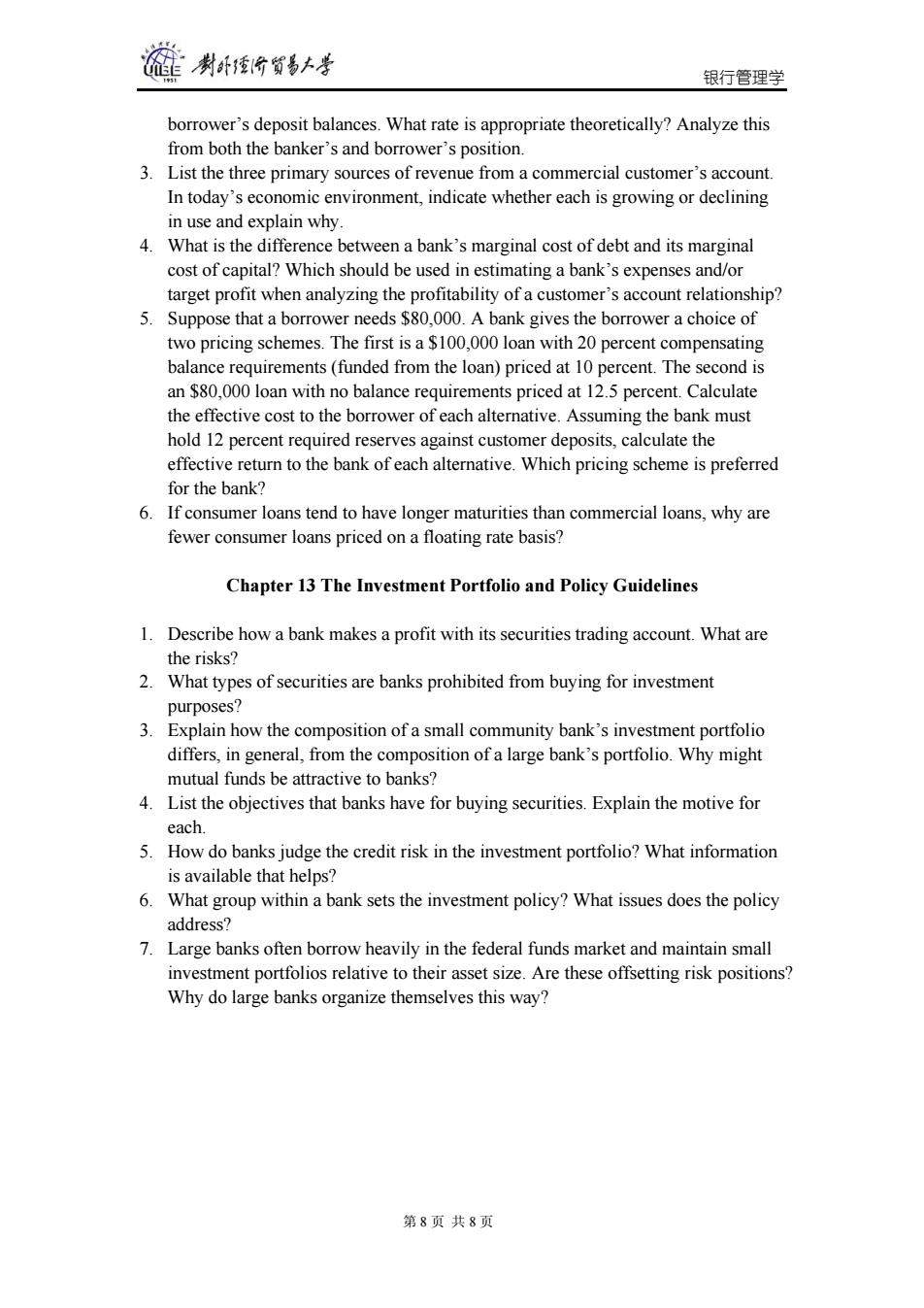正在加载图片...

莲 制卧爱分货易+学 银行管理学 borrower's deposit balances.What rate is appropriate theoretically?Analyze this from both the banker's and borrower's position. 3.List the three primary sources of revenue from a commercial customer's account. In today's economic environment,indicate whether each is growing or declining in use and explain why. 4.What is the difference between a bank's marginal cost of debt and its marginal cost of capital?Which should be used in estimating a bank's expenses and/or target profit when analyzing the profitability of a customer's account relationship? 5.Suppose that a borrower needs $80,000.A bank gives the borrower a choice of two pricing schemes.The first is a $100,000 loan with 20 percent compensating balance requirements(funded from the loan)priced at 10 percent.The second is an $80,000 loan with no balance requirements priced at 12.5 percent.Calculate the effective cost to the borrower of each alternative.Assuming the bank must hold 12 percent required reserves against customer deposits,calculate the effective return to the bank of each alternative.Which pricing scheme is preferred for the bank? 6.If consumer loans tend to have longer maturities than commercial loans,why are fewer consumer loans priced on a floating rate basis? Chapter 13 The Investment Portfolio and Policy Guidelines 1.Describe how a bank makes a profit with its securities trading account.What are the risks? 2.What types of securities are banks prohibited from buying for investment purposes? 3.Explain how the composition of a small community bank's investment portfolio differs,in general,from the composition of a large bank's portfolio.Why might mutual funds be attractive to banks? 4.List the objectives that banks have for buying securities.Explain the motive for each. 5.How do banks judge the credit risk in the investment portfolio?What information is available that helps? 6.What group within a bank sets the investment policy?What issues does the policy address? 7.Large banks often borrow heavily in the federal funds market and maintain small investment portfolios relative to their asset size.Are these offsetting risk positions? Why do large banks organize themselves this way? 第8页共8页银行管理学 第 8 页 共 8 页 borrower’s deposit balances. What rate is appropriate theoretically? Analyze this from both the banker’s and borrower’s position. 3. List the three primary sources of revenue from a commercial customer’s account. In today’s economic environment, indicate whether each is growing or declining in use and explain why. 4. What is the difference between a bank’s marginal cost of debt and its marginal cost of capital? Which should be used in estimating a bank’s expenses and/or target profit when analyzing the profitability of a customer’s account relationship? 5. Suppose that a borrower needs $80,000. A bank gives the borrower a choice of two pricing schemes. The first is a $100,000 loan with 20 percent compensating balance requirements (funded from the loan) priced at 10 percent. The second is an $80,000 loan with no balance requirements priced at 12.5 percent. Calculate the effective cost to the borrower of each alternative. Assuming the bank must hold 12 percent required reserves against customer deposits, calculate the effective return to the bank of each alternative. Which pricing scheme is preferred for the bank? 6. If consumer loans tend to have longer maturities than commercial loans, why are fewer consumer loans priced on a floating rate basis? Chapter 13 The Investment Portfolio and Policy Guidelines 1. Describe how a bank makes a profit with its securities trading account. What are the risks? 2. What types of securities are banks prohibited from buying for investment purposes? 3. Explain how the composition of a small community bank’s investment portfolio differs, in general, from the composition of a large bank’s portfolio. Why might mutual funds be attractive to banks? 4. List the objectives that banks have for buying securities. Explain the motive for each. 5. How do banks judge the credit risk in the investment portfolio? What information is available that helps? 6. What group within a bank sets the investment policy? What issues does the policy address? 7. Large banks often borrow heavily in the federal funds market and maintain small investment portfolios relative to their asset size. Are these offsetting risk positions? Why do large banks organize themselves this way?